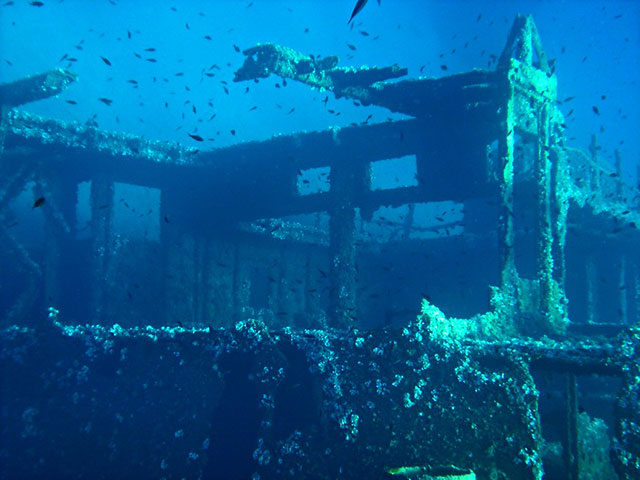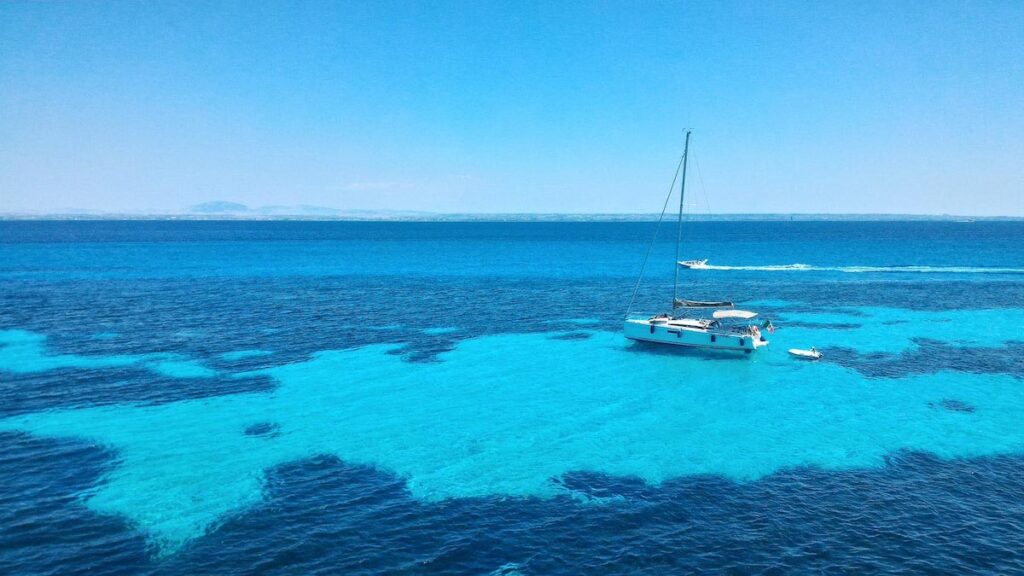Known for its mouthwatering food, ancient history and rolling landscapes of olive groves and vineyards, Italy attracts tourists from all corners of the world. This magnificent country is equally as rich below the waterline, with crystal-clear warm waters and numerous Marine Protected Areas. There is something for every diver in Italy, with sheer pinnacles, walls, caves, thriving reefs, and wrecks from Roman times to WWII. You can even explore an underwater archaeological park with ancient villas and Roman artefacts whilst you’re there. Read on to find out more in our ultimate guide to scuba diving in Italy.
8 great places to go diving in Italy
1. Sardinia
Sardinia is the second largest island in the Mediterranean and boasts over 100 beaches, three Marine Protected Areas and numerous dive sites, all of which make diving in Sardinia difficult to beat. There is something for every diver at this idyllic destination, ranging from rugged caves, wrecks and technical dives to easy shore dives.
The northwest coast has easy dives for new divers, whilst experienced divers will enjoy the KT12 and Nasello wrecks in East Sardinia. If you want to go cave diving, take a trip to St. Elmo’s Rock and the Grotta del Nereo. Together they form a series of caves and tunnels that stretch over 350 meters and host abundant marine life.
2. Puglia
Tucked away in Southern Italy, Puglia or Apulia, is less well known than other Italian dive destinations but don’t let that fool you. Puglia offers excellent diving, with more than 40 pristine dive sites along the region’s seemingly-endless coastline.
Tremiti, an archipelago of five islands strewn across aquamarine waters, offers unique island dives in Marine Protected Areas that are ideal for experienced divers. Being relatively undiscovered, the waters are peaceful and there is plenty of marine life to find among the underwater caves, volcanic landscapes and rocky archways.
3. Calabria
Sitting directly opposite the Apulia region, at the toe of the Italian boot, Calabria is another must-visit Italian hidden gem. This region is largely untouched by mass tourism and has long sandy beaches with few crowds, traditional Italian villages and the largest protected nature reserve in Italy.
Head below the waterline and you will discover a world of idyllic reefs, caves, pinnacles, sheer cliffs and amazing wrecks that few people have dived. Strong currents attract diverse marine life to the dive sites off Reggio Calabria, which sits on the strait between the Italian mainland and Sicily. As well as hosting numerous swordfish, you can dive with tuna, scorpion fish and plenty of other pelagic marine life there.
4. Tuscany
Take a trip to the Tuscan coast for glorious white sand beaches, azure waters and a range of Italy’s best-known dive sites. Elba Island, in the Tuscan Archipelago National Park, was made famous by Napoleon’s exile on the island and is one of the most popular areas to go diving in Italy.
Elba’s protected waters have abundant marine life and numerous dive sites, including the famous Elviscott wreck. Sitting at just 12 meters deep and busy with fish life, this wreck is ideal for new divers. Whilst you’re there, you can also explore an underwater museum just off the coast in the Corsican Canal. This underwater collection of statues depicts historical and mythological figures and is well worth visiting.
 Image: Federico Scorzoni | CC BY 2.0 GenericImage: Federico Scorzoni | CC BY 2.0 Generic
Image: Federico Scorzoni | CC BY 2.0 GenericImage: Federico Scorzoni | CC BY 2.0 Generic5. Liguria
Bordered by the impressive Alps and the Ligurian Sea, and home to the world-famous Italian Riviera, the Liguria region is no stranger to tourism. Its pastel-hued towns perched on sheer cliffs, luxury yachting destinations and crystal-clear blue waters have featured in magazines around the world.
If you can take your eyes off the landscapes above water, you will find fascinating underwater canyons, vertical walls, coral-encrusted wrecks and pinnacles teeming with life. With visibility reaching up to 30 meters and dives sites scattered throughout Liguria’s three Marine Protected Areas, it is one of the best regions to go diving in Italy.
When you’ve had enough of diving, work up your best appetite exploring Liguria’s four UNESCO World Heritage Sites before indulging in this region’s mouthwatering food and wine.
6. Campania
The Campania region in Southern Italy hosts the famous Amalfi Coast; one of the most sought-after tourist destinations in the world. This region is fringed with pretty beaches and is home to an underwater archaeological park that you can dive or snorkel.
 Image: Tom Podmore/UnsplashImage: Tom Podmore/Unsplash
Image: Tom Podmore/UnsplashImage: Tom Podmore/UnsplashOnce a buzzing resort town, Baiae was sent to the seabed by volcanic activity and is now a fascinating place to dive. There you can explore the remains of ancient villas, mosaics, and other Roman artefacts. There are a number of dive sites at Baiae, with highlights including the Sunken Nymphaeum (a collection of Roman statues), spas, paved roads, fallen columns and more.
Nestled among cliffs and looking towards Mt Vesuvius, Sorrento has great diving and sailing opportunities. Diving in Sorrento included caves, caverns and drop-offs in deep blue waters, with plenty for all experience levels. The protected waters of Punta Pampanella offer stunning coastal dives, whilst the tiny island of Socglio del Vervece has a 40-meter-deep wreck, pretty gorgonian sea fan gardens, and an underwater bronze statue of the Virgin Mary.
If you’re an experienced diver looking for something new, visit Campania’s Mitigliano Grotto. This karst formation is a cave dive with a maximum depth of 20 meters and offers an 80-meter-long route. The passageways are narrow, there are rare cave-dwelling fish to find, and you can surface in air-filled chambers along the way.
7. Sicily
The largest island in the Mediterranean Sea, Sicily diving is synonymous with diverse rocky scenery and vibrant marine life. There are small archipelagos to explore just off Sicily’s beautiful shores, plus hidden bays, coves, cliffs and stacks that can be easily reached by boat. Crowned by Mount Etna, there are also volcanic landscapes, plus basalt and granite formations at Sicily’s many dive sites. All of which are surrounded by warm waters with up to 30 meters visibility.
Aci Trezza, famous for its rows of basalt columns above and below water, is an ideal base for scuba diving in Sicily. There is excellent Marine Protected Area diving there, with huge gorgonians, seahorses and numerous fish, plus a variety of wrecks dating from Roman times through to World War II.
 Image: Samuel Ferrara/UnsplashImage: Samuel Ferrara/Unsplash
Image: Samuel Ferrara/UnsplashImage: Samuel Ferrara/Unsplash8. Lazio
Lazio in central Italy might not be your first choice for a diving holiday but you’ll be surprised by the scuba diving there. The bustling city of Rome has a range of dive sites, including the well-known Saint Lucia wreck. Sitting just off the coast of Rome, the Saint Lucia was sunk during World War II and lies in two pieces at 44 meters deep. Her propeller and anchors are still intact, and she is a thriving artificial reef, making her a popular spot for underwater photographers. Costacuti Reef is also well worth visiting to dive a deep wall of red gorgonians, with a roman anchor tucked away amongst them.
What experience do you need to go diving in Italy?
With so many different destinations to choose from, Italy is suitable for all dive experience levels.
When is the best time to go diving in Italy?
You can go scuba diving in Italy all year. Summer water temperature reach up to 28 °C and drop to 10 – 13 °C in winter.
- Summer is the best time to visit for abundant marine life.
- Visit Elba Island from June to August for eagle rays and seahorses.
- Go diving in Sicily from May to October for the best water conditions.
Image credits:
- Italy: Antonio Sessa/Unsplash
- elviscott: Federico Scorzoni | CC BY 2.0 Generic
- Amalfi: Tom Podmore/Unsplash
- Sicily: Samuel Ferrara/Unsplash
